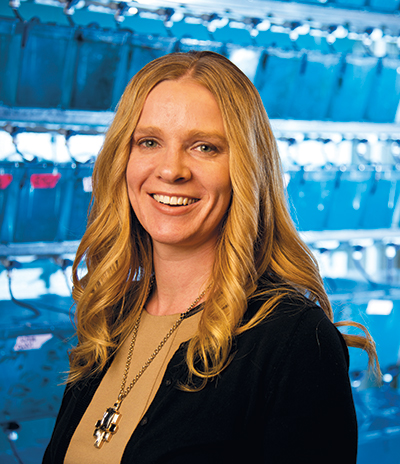Is Your Drinking Water Safe?
Researcher focuses on advancing toxicology data efforts to understand how chemicals can harm our health
Story by Phillip Fiorini
More than 10,000 gallons of a potentially toxic, coal-cleaning liquid spilled into the Elk River, centered near West Virginia’s capital city of Charleston, in early January 2014. Soon after, residents noticed a strong order similar to black licorice coming from their faucets.
The chemical, known as methylcyclohexanemethanol (MCHM), had entered a local water source, and the drinking water of more than 300,000 residents in nine West Virginia counties was contaminated. A statewide emergency was declared, and health officials were looking for answers, specifically to whether the local drinking water was safe.
“As the concentration went up, the smell got more intense — a very intense black licorice smell. And that led to the heightened concern, because everyone could smell it,” says Jennifer Freeman, an associate professor of toxicology in Purdue University’s School of Health Sciences. Her team was the first to directly evaluate the toxicity of the chemicals spilled into the Elk River.
 Jennifer Freeman, associate professor of toxicology (Photo by Steven Yang)
Jennifer Freeman, associate professor of toxicology (Photo by Steven Yang)
The West Virginia spill points to the broader problem of the dearth of available data to identify what chemical compounds have the potential to disrupt biological processes in the human body, leading to serious negative health effects, Freeman says.
More than 90,000 chemicals are used by thousands of industries for growing crops, smelting steel, mining for coal, drilling for oil — everything that helps drive U.S. manufacturing and fuels the economy. Detailed toxicology data exist for just a fraction of those chemicals. As a toxicologist, Freeman is determined to change that.
“As a researcher, I put myself in their shoes, as if I am the one drinking the water. The Elk River chemical spill is just one example,” Freeman says. “For me, the take-home is this: We have 90,000 chemicals that are available in commerce, but we only have decent toxicity data for about 200 of them. When it comes down to it, if chemical X — whatever it might be — is spilled in or near a community that is using surface water as their drinking water source, you could be faced with this problem again.”
Credible sample needed for researchers
Andrew Whelton, at the time a professor at the University of South Alabama and now an associate professor of both civil engineering and environmental and ecological engineering at Purdue, immediately traveled to West Virginia. His goal: to obtain credible chemical samples, characterize them and collaborate with expert toxicologists like Freeman, who could scientifically address the questions and concerns from the public, as well as from state and local health officials.
“The exposures affected 300,000 people. It was indiscriminate — healthy adults, pregnant women, children, those with COPD issues,” says Whelton, whose expertise is in water treatment chemistry and infrastructure systems. “Many people had real questions about the safety of their licorice-smelling drinking water. I was limited in answering people’s questions: Is it safe? Are my children going to get cancer? Am I going to have long-term inhalation lung problems? I knew the community needed the type of expertise that Professor Freeman has.”
The findings by Freeman’s team suggested that a mixture of compounds individually at levels deemed safe had the potential for toxicity — and the residents of Charleston were exposed to multiple chemicals simultaneously in their drinking water. The group conducted a toxicological assessment on an MCHM mixture from the leaking barrel, Tank 396.
Using the zebrafish model, a genome known to be 70% similar to humans and that behaves similarly when exposed to toxicity, Freeman is able to study how the effects of exposure to harmful chemicals can affect human health at different stages of life. Longer term, her goal is to try to define the underlying genetic and epigenetic mechanisms of the toxicity of environmental stressors and determine the potential for neurological disorders, reproduction dysfunction and cancer.
After exposure to the three MCHM samples from the Elk River spill, Freeman says, the zebrafish that her team studied experienced malformations and mortality at higher concentrations of the chemical. However, she notes that the effects on humans exposed to the chemicals are not known. Although some residents reported respiratory issues and other problems from inhaling the chemical’s fumes, studies that followed up on the incident have not found any long-term health impacts on the residents, she says.
In June 2019, the National Toxicology Program released a study that concluded “clear evidence of developmental toxicity from MCHM” in a rodent study with reduced fetal weight, adrenal malformations and increased malformations of the axial skeleton. Freeman says those results align with the morphological alterations from exposure to MCHM that her team saw.
More than $160 million has been paid out to residents as part of a settlement of a class-action lawsuit filed against the chemical tank farm owned by Freedom Industries Inc., chemical maker Eastman Chemical Co. and West Virginia American Water Co.
‘Measured what no one else measured’
The Elk River spill has had a profound effect on Maya Nye, who recalls driving to the Kanawha Valley in early January 2014 to confront a noticeable chemical odor in the air from what would later be determined to be MCHM. Even before the Elk River spill, Nye had spent nearly three decades as an environmental advocate, serving as the spokesperson for the group People Concerned About Chemical Safety. After the West Virginia spill, she assisted in establishing the community group Advocate for a Safe Water System.
And now, Nye is pursuing a doctorate in public health from West Virginia University. She hopes to complete her dissertation, centered on the Elk River chemical leak as a case study that examines the associations between governmental disaster management and environmental health disparities, by May 2020.
“Indeed, I am utterly thankful to Dr. Freeman and the Purdue team,” Nye says. “By investigating the effects of the chemical mixture instead of the individual chemicals one at a time, like most of the other toxicological studies had done, their study helped us better understand how people actually experienced exposure. They definitely measured what no one else measured, and it helped us address important exposure questions not previously understood.”

